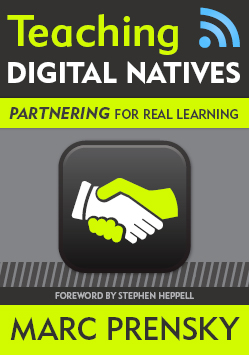
CHAPTER 8:
1. How can I elicit maximum creation from my students related to their learning?
I should begin by asking open-ended guiding questions. Not only does this force me to become the “guide on the side,” students must give thoughtful and complex answers. Of course, this requires students to take control of their own learning and allows them to be as creative as they wish. They may use any number of tools and technologies to answer the question and may even incorporate their interests (leading to a much higher level of engagement). Further, this kind of choice signals to students that their opinions/likes/dislikes really matter to the teacher and they will be more willing to produce creative classroom tasks.
2.How can I help my students engage in world conversations?
In the past, students produced work simply to show one person: the teacher. This method doesn’t make much sense in the 21st century; most everything kids interact with today can be shared anywhere at anytime. I can change this by having students post their work on the web (blogs, wikis, youtube, etc.) This will help make their learning real and relevant. Personally, I liked Prensky’s idea of having students write persuasive pieces to their local politicians or post them on message boards (as a Social Studies teacher, I’m constantly looking for new ways to teach the importance of civics).
3.How can I continually raise the bar for my students’ creations?
Prensky makes an excellent point: we must not praise or evaluate student work too highly simply for using technology or completing the given task. Students should be encouraged to put as much of themselves into their work as they can. This means they should incorporate their interests (along with the content) and constantly challenge their own creativity. The teachers should only offer advice on assignments and inspire students to accomplish great things on their own.
I should begin by asking open-ended guiding questions. Not only does this force me to become the “guide on the side,” students must give thoughtful and complex answers. Of course, this requires students to take control of their own learning and allows them to be as creative as they wish. They may use any number of tools and technologies to answer the question and may even incorporate their interests (leading to a much higher level of engagement). Further, this kind of choice signals to students that their opinions/likes/dislikes really matter to the teacher and they will be more willing to produce creative classroom tasks.
2.How can I help my students engage in world conversations?
In the past, students produced work simply to show one person: the teacher. This method doesn’t make much sense in the 21st century; most everything kids interact with today can be shared anywhere at anytime. I can change this by having students post their work on the web (blogs, wikis, youtube, etc.) This will help make their learning real and relevant. Personally, I liked Prensky’s idea of having students write persuasive pieces to their local politicians or post them on message boards (as a Social Studies teacher, I’m constantly looking for new ways to teach the importance of civics).
3.How can I continually raise the bar for my students’ creations?
Prensky makes an excellent point: we must not praise or evaluate student work too highly simply for using technology or completing the given task. Students should be encouraged to put as much of themselves into their work as they can. This means they should incorporate their interests (along with the content) and constantly challenge their own creativity. The teachers should only offer advice on assignments and inspire students to accomplish great things on their own.
No comments:
Post a Comment